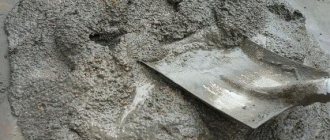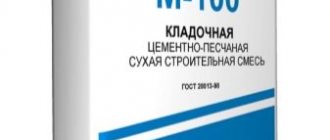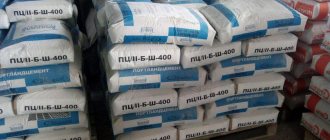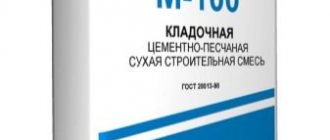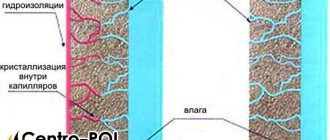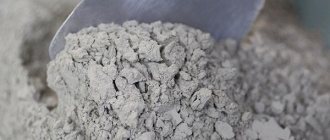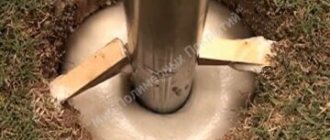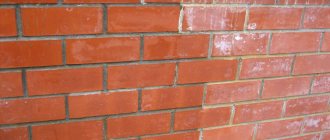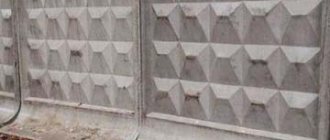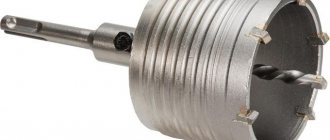Despite the wide selection of all kinds of building materials, concrete and cement mortar are often used in construction. You need to understand the difference between cement and concrete in order to use these materials correctly. They have different structure and purpose. Mixtures are produced at production plants for use in the construction industry.
Concrete and cement are materials that are used for different purposes and have different compositions.
Main Differences
In construction, specific materials are used that are characteristic of this industry and have a certain appearance and characteristics.
Such materials are cement and concrete.
By mixing water, cement and sand in the right ratio, you can get a good cement mortar.
Where and how are they used? What is the difference between concrete and cement and what are they made of? You will learn about this further.
What is concrete?
This is a material that is often used when laying foundations, laying works or other areas. When laying the foundation, additional reinforcement can be added. This is done to increase the strength and reliability of the resulting structure. A reinforced belt is used in cases where it is necessary to achieve the strength of the resulting structure so that it does not burst. When pouring, many experts advise using not a welding method to fasten the reinforcement, as many do, but tying it together using soft wire. This point will improve the issues of bending strength of the structure. Concrete can belong to different classes and brands. Each of the above points has its own characteristics and advantages that influence everyone’s choice. Very often in construction, additives of various types can be additionally used to obtain the required strength, reliability and efficiency.
Types of construction cement
Scheme of ultimate strength of VBC and VRC
White is a material of finely ground clinker with gypsum.
Colored cements are obtained from white cements by adding coloring additives. But this reduces their strength.
These two types are used in the decoration of buildings.
Fast-hardening - it has a very high rate of increase in strength during hardening. It is used in masonry work.
Concretes and mortars containing aluminous ingredients have high water resistance and fast setting time.
All types of cement have a grade indicating its strength: the higher the grade, the stronger the structure created on the basis of this material.
Relationship between materials
Improvement in concrete preparation technology directly depends on cement.
The main component of concrete is cement. The connection between them is as follows: the higher the adhesive ability of cement, the stronger the concrete will be.
In the manufacture of concrete and reinforced concrete structures, various cements are used. They are selected based on the type of structure for which concrete will be used. The price of concrete will depend on what brand of cement it is.
The grade of cement is selected depending on the grade of concrete in terms of compressive strength:
| Concrete grades | M150 | M200 | M250 | M300 | M350 | M400 | M450 | M500 | M600 and above |
| Cement brands | M300 | M300 M400 | M400 | M400 M500 | M400 M500 | M500 M600 | M550 M600 | M600 | M600 |
If the grade of cement is higher than that recommended for a given concrete, it is necessary to dilute it with a finely ground active additive in order to avoid excess consumption of material.
Binding base for mortar
Cement is an artificial binder that, through interaction with water and other liquids, produces a plastic mass that hardens over a certain time. The dry mixture is most often supplied to markets in paper packages. The weight of one bag is usually 50 kg.
Production process
The material for producing building mixtures for various purposes is made by heating lime and clay or similar components to a temperature of 1450 degrees. A homogeneous mass melts, forming clinker granules, which are subsequently combined with gypsum. The result is a finely ground composition.
The calcareous mineral can be replaced by some varieties of calcium sulfates. Sometimes technical conditions allow the use of other materials.
- Alite is the most important constituent of the cement intermediate product
. Its content ranges from 50 to 70 percent. The structure and composition of the compound are modified due to the placement of foreign ions. - Belite is a dicalcium silicate, which increases the strength characteristics of building mixtures over a long period of time. It is contained in an amount of 15-30 percent of the total mass.
- The aluminate phase
is tricalcium aluminate, which quickly reacts with water. If a holding agent such as gypsum is not added, undesirable setting may occur. - The ferrite phase
is necessary for the construction mixture to actively harden during the initial period of pouring. The rate of hardening may vary slightly depending on the composition and other characteristics.
Note! Cement clinker most often contains other phases, which include: calcium oxide and alkali sulfates. Their content inside the substance is quite small.
Specifications
There are several types of cement products, but Portland cement is especially popular, so you should focus on it. Its properties may vary slightly depending on the brand, but in any case it must meet the established requirements of GOST 10178-85, which are reflected in the table below.
Addition! The weight of 1 m3 of cement is approximately 1300 kg, but the final weight will depend on the moisture content of the material and the brand. In addition, its density may increase during long-term storage.
Strength marking
The packaging of the binder composition is usually marked with special markings that take into account the ability of the material to withstand a certain load. In this case, the letter M and a number corresponding to the number of kilograms are placed.
The weight of a cube of high grade cement may be slightly greater. The most popular products are M400 and M500.
The main differences between concrete and cement
So, what is the difference between concrete and cement? Concrete is obtained as a result of molding and hardening of a special solution. This is an artificial stone that is obtained by mixing several components. To make it you need:
- cement;
- water;
- small and large fillers (for example, crushed stone).
Concrete mixtures require careful selection of ingredients and have GOST standards, on the basis of which they are manufactured.
Concrete contains large fillers (gravel and crushed stone). In cement, sand is used as an inert filler.
When purchasing this or that material, you should choose exactly the type that is needed for a particular type of work in order to avoid unnecessary costs.
Construction mixture for structures
The most important difference between concrete and cement is its purpose. A binder is necessary to obtain a building composition, and the composition itself is needed to create various structures. After hardening, an artificial stone is formed, which can be given any shape.
Main components
The building mixture can be prepared with your own hands within a short period of time, which cannot be said about cement. During the preparation process, it is necessary to select the correct proportions in order to obtain the composition of a certain brand or class.
The basic ones are discussed below.
- During physical and chemical processes, the binder is capable of hardening over a certain period of time. It turns into a stone-like state, holding the other components together.
- Sand acts as a fine aggregate. Its granulometric composition influences technological parameters. As the particle size modulus decreases, the consumption of binder increases.
- Gravel is a coarse aggregate that takes up most of the volume of the mixture. Strength characteristics depend on its quality. The basic requirements are regulated by clauses of GOST 10268-80.
- Water performs two functions at once. First of all, it is necessary for a chemical reaction to occur. It also helps to lubricate the components, making the mixture easy to apply.
Attention! To calculate cement for concrete and find out the amount of other components, you need to decide on the class of the mixture to be prepared for any structure.
Proportions for obtaining a solution
The ratio of all substances depends on what brand of composition needs to be prepared, as well as on the binder used. As for the amount of water, it is selected depending on the weight of the main component. The liquid should be half the mass of cement.
| Cement used | Concrete grade | Gravel-sand-cement |
| M400 | 100 | 7-4,6-1 |
| 150 | 5,7-3,5-1 | |
| 200 | 4,8-2,8-1 | |
| 250 | 3,9-2,1-1 | |
| 300 | 3,7-1,9-1 | |
| 400 | 2,7-1,2-1 | |
| 450 | 2,5-1,1-1 | |
| M500 | 100 | 8,1-5,8-1 |
| 150 | 6,6-4,5-1 | |
| 200 | 5,6-3,5-1 | |
| 250 | 4,5-2,6-1 | |
| 300 | 4,3-2,4-1 | |
| 400 | 3,2-1,6-1 | |
| 450 | 2,9-1,4-1 |
Important! After studying the proportions, you can easily calculate the volume of concrete from 50 kg of cement. In this case, it will become clear how much mixture will be obtained from one bag.
Binder consumption
When creating various structures, you will have to calculate the cement per cube of concrete, because the usual unit of volume is m3. Preliminary calculations are necessary to purchase the required amount of material. The approximate consumption of binder is presented in the table below.
| Class of the resulting mixture in kilograms per cubic meter | Cement brand | ||
| M500 | M400 | M300 | |
| B10 | — | — | 210-265 |
| B12.5 | — | 210-265 | 230-290 |
| B15 | 200-240 | 220-275 | 255-320 |
| B20 | 235-293 | 265-330 | 300-385 |
| B25 | 265-335 | 310-395 | — |
| B30 | 310-355 | 355-455 | — |
| B35 | 355-455 | — | — |
| B40 | 415-520 | ||
Note! The table shows the rate of cement per cubic meter of concrete in kilograms. Thus, knowing the volume of filling, you can easily calculate the number of packages with binder.
Product classification
- Depending on the purpose, regular and special formulations are distinguished. The first of them are used in civil and industrial construction, and the second - when constructing facilities with increased requirements for quality and safety.
- The type of binder can act as a classifier; therefore, cement, gypsum, silicate and other compositions are distinguished. The list is not limited to these components.
- Solutions are also divided according to the type of filler, since it can be dense, cellular, porous or large-porous. The qualitative characteristics that concrete made from cement and sand will have will differ in this case.
- Classification is also made according to hardening conditions, because mixtures can harden both in natural conditions and during heat treatment under high or atmospheric pressure.
Compaction is carried out using vibration equipment, the price of which is high. During shaking, the particles of the mixture are suspended, so the connection with other components is disrupted. During subsequent movement, the force of the push forces the molecules to take a more advantageous position.
Differences in composition
- resist moisture;
- withstand mechanical loads;
- do not change properties due to other environmental factors.
Concrete is a man-made material. Includes:
- cement;
- sand;
- crushed stone;
- water.
To prepare concrete, plasticizers or water-repellent additives are used.
An important condition is to correctly determine the brand of cement.
Preparation of sand concrete
An experienced builder is able to prepare this composition independently. For this you will need water, sand and Portland cement M 500. The proportions are simple - 3.5 kg of cement and no more than 2.5 liters of water are needed per bucket of sand.
The consumption of the prepared mixture is determined by the following conditions:
- required thickness;
- base parameters;
- high-quality condition of the finishing coating.
If a concrete mixer is used, the components must be dry so that they mix well.
Having laid the sand, add cement, stir and pour in water. The material will be homogeneous and will meet the strength requirements of M 300. The mixture is kneaded for several minutes, then sent to work.
Kawabanga! Brand of concrete for the foundation of a private house
The brand of Portland cement used affects the strength of the sand concrete mass, and the sand fractions determine the degree of shrinkage. A universal option is composition M 300, although in practice it has been proven that low-grade solutions can also be used.
Transportation and storage of such material is carried out in four-layer paper containers that reliably protect from moisture.
What is the difference between cement mortar and concrete?
Features of concrete
Concrete is a stone produced artificially . The process of obtaining it involves the combination of several components. The main ones are cement, water and additives of varying degrees of grinding.
The latter is small and strong pebbles, crushed stone, etc. There are many technologies for producing artificial stone. Some types do not require the addition of water.
It is composite, since the process of its manufacture includes the stage of formation and hardening of the mixture. This property is determined by the presence of cement in the composition. The latter is a powder of mineral origin.
It has binding properties and, when mixed with water, forms a dough-like mass that hardens at a certain temperature and becomes hard as a rock. The consistency is homogeneous.
To increase strength, metal reinforcement . This type of stone is classified according to different parameters.
Depending on the purpose, it can be ordinary, special and with special properties. The first one is best suited for the construction of residential buildings and industrial buildings. The second is suitable for road and hydraulic works.
The latter has additional abilities such as sound absorption, resistance to high temperatures, reflect radiation and many others.
Features of cement mortar
The mixture obtained by combining cement, water and sand is called cement mortar. In construction, it can be used either in its pure form or by adding other components that are added during mixing.
These ingredients form a plastic mixture, which then hardens, becomes durable and is equal in strength to stone. Moreover, this happens not only in the air, but also at increased humidity.
What is the difference?
These materials have a number of differences. The main one is the composition. The artificial stone contains coarse crushed stone or gravel, and the mortar contains sand. They are not the main raw materials, but play an important role in shaping the properties of mixtures.
Since concrete has the best strength indicator, it is used as parts in the construction of buildings. They can be of medium or large dimensions and form the supporting structure of the building.
Let's sum it up
Concrete and cement mortar are one of the main materials in construction. The first consists of cement, water, sand and filler. The second is made of cement, sand and water. Additional components cause differences in materials.
Concrete is an element of construction . He takes an active part in the formation of the supporting structure. Can be a large or medium item
The mortar provides strong adhesion to bricks or other building materials. It penetrates the seams and fills them. Often used when treating surfaces after a building has been erected.
Characteristics of concrete mortar
When making a concrete mixture, cement is a binder that ensures its hardening.
Concrete is a compound that, when liquid is added, turns into a fairly solid structure. In a concrete mixture, cement acts as a binder, which ensures better hardening and setting. Therefore, concrete mixture is considered to be a composite material. The big advantage is that it is used for the construction of large (including load-bearing) building structures, which explains the difference in the use of concrete and cement mortars.
Typically, the consistency of concrete includes sand, gravel (or granular slag) and cement.
Selection of sand and cement
To make a concrete mixture, you need to take clean sand.
Not just any cement can be used, but a special one. Portland cement, well known in the construction industry, is best suited. This is a fairly heavy and high-strength type of cement. It is usually marked from M350 to M500. Cement of lower grades (less than M350) is definitely not suitable for concrete mortar, but is perfect for cement mortar, which will subsequently be used for plastering work.
As for choosing the grade of sand for cement, there are no special requirements. The sand just needs to be fairly clean, river sand, and it shouldn’t contain clay impurities.
Choosing the main filler for concrete
Often, gravel or slag of two fractions is used as the main filler in concrete mortar: large and fine. This is necessary to ensure greater reliability of the solution. It is best to choose granite gravel of several fractions as a filler. No other gravel (carbonate, gypsum, chalk and others) needs to be used, since over time it begins to crumble very much, and therefore is quite poorly fixed in the composition.
Main Differences
In construction, specific materials are used that are characteristic of this industry and have a certain appearance and characteristics.
Such materials are cement and concrete.
By mixing water, cement and sand in the right ratio, you can get a good cement mortar.
Where and how are they used? What is the difference between concrete and cement and what are they made of? You will learn about this further.
Types of construction cement
Scheme of ultimate strength of VBC and VRC
White is a material of finely ground clinker with gypsum.
Colored cements are obtained from white cements by adding coloring additives. But this reduces their strength.
These two types are used in the decoration of buildings.
Fast-hardening - it has a very high rate of increase in strength during hardening. It is used in masonry work.
Concretes and mortars containing aluminous ingredients have high water resistance and fast setting time.
All types of cement have a grade indicating its strength: the higher the grade, the stronger the structure created on the basis of this material.
Relationship between materials
Improvement in concrete preparation technology directly depends on cement.
The main component of concrete is cement. The connection between them is as follows: the higher the adhesive ability of cement, the stronger the concrete will be.
In the manufacture of concrete and reinforced concrete structures, various cements are used. They are selected based on the type of structure for which concrete will be used. The price of concrete will depend on what brand of cement it is.
The grade of cement is selected depending on the grade of concrete in terms of compressive strength:
| Concrete grades | M150 | M200 | M250 | M300 | M350 | M400 | M450 | M500 | M600 and above |
| Cement brands | M300 | M300 M400 | M400 | M400 M500 | M400 M500 | M500 M600 | M550 M600 | M600 | M600 |
Kawabanga! Task 5
If the grade of cement is higher than that recommended for a given concrete, it is necessary to dilute it with a finely ground active additive in order to avoid excess consumption of material.
Designation of concepts
- Cement mortar is a composition created from water, sand, and cement. In addition, various plasticizers are often added to this list, increasing the strength, resistance to sub-zero temperatures, moisture resistance and other qualities in the solution.
- Concrete is an artificial stone created by combining water, cement, large and small aggregates, which can be pebbles, crushed stone or gravel. Concrete is also called a composite formed from a special hardening mixture.
Definition of quality
Before use, it is very important to ensure that the quality of the concrete solution is sufficient. Usually quality is determined visually. If there are uncovered ones in the solution, then it is necessary to add a little more sand to the mixture for greater viscosity. Another way to check the quality of concrete is by hitting it with a shovel. To do this, hit the concrete flat with force with an iron shovel: if the voids are almost not filled again with mortar, then there is not enough cement in the mixture. And if the mark remains too deep, then, on the contrary, the concrete has excess cement.
Characteristic differences of concrete
Main components
- cement;
- sand;
- gravel as filler.
If the filler is crushed stone, then it is advisable to completely hide this filler inside the solution. This can be done by mixing a little more sand into the composition for better viscosity.
Additional impurities
These include plasticizers and reinforcing substances.
Plasticizers
Reinforcing impurities
When concrete needs special strength and durability, for example, when pouring the foundation for a building on unstable soil, special reinforcing admixtures are added inside the solution.
Among such impurities, the most popular are:
- metal threads of a special type;
- fiberglass;
- polymer fibers;
- basalt fibers.
Basalt fiber.
Among them, basalt fiber stands out. It is resistant to rotting and high temperatures during fires, plus it has the highest strength.
But before you start mixing, carefully study the description attached to this supplement. Strictly adhere to the recipe specified in it - add to the mixture exactly the amount of reinforcing substance that the manufacturers recommend.
Types of concrete
By weight:
- especially light;
- easy;
- lightweight;
- heavy;
- especially heavy.
By purpose:
- special - resistant to chemical reactions, radioactive radiation, high fire temperatures and sub-zero thermometer readings;
- structural – intended for load-bearing structures made of concrete and reinforced concrete;
- straining – impregnated with monopolymers,
By type of binder:
- gypsum - made from slag materials with the addition of gypsum anhydrite binders;
- cement - the composition is based on Portland cement;
- silicate - a mixture of binder lime raw materials and aluminate or silicate materials.
The difference between concrete and cement
In construction, specific materials are used that are characteristic of this industry and have a certain appearance and characteristics.
Such materials are cement and concrete.
By mixing water, cement and sand in the right ratio, you can get a good cement mortar.
Where and how are they used? What is the difference between concrete and cement and what are they made of? You will learn about this further.
Definition of terms
Cement is a powdery substance that, when mixed with water, resembles a dough-like mass, and when this mass hardens, it becomes a homogeneous solid.
Cement mortar is a mixed mass that consists of water, sand and cement. Additional plasticizers can also be added to it, which increase the strength, frost resistance, water resistance and other characteristics of the cement mortar.
The classification of these building materials is very diverse. To better understand how cement mortar differs from concrete, let’s first consider their types and relationships.
Types of construction cement
Scheme of ultimate strength of VBC and VRC
White is a material of finely ground clinker with gypsum.
Colored cements are obtained from white cements by adding coloring additives. But this reduces their strength.
These two types are used in the decoration of buildings.
Fast-hardening - it has a very high rate of increase in strength during hardening. It is used in masonry work.
Concretes and mortars containing aluminous ingredients have high water resistance and fast setting time.
All types of cement have a grade indicating its strength: the higher the grade, the stronger the structure created on the basis of this material.
Types of concrete by purpose and type of binder
Based on the type of binder, they are divided into:
Relationship between materials
Improvement in concrete preparation technology directly depends on cement.
The main component of concrete is cement. The connection between them is as follows: the higher the adhesive ability of cement, the stronger the concrete will be.
In the manufacture of concrete and reinforced concrete structures, various cements are used. They are selected based on the type of structure for which concrete will be used. The price of concrete will depend on what brand of cement it is.
The grade of cement is selected depending on the grade of concrete in terms of compressive strength:
| Concrete grades | M150 | M200 | M250 | M300 | M350 | M400 | M450 | M500 | M600 and above |
| Cement brands | M300 | M300 M400 | M400 | M400 M500 | M400 M500 | M500 M600 | M550 M600 | M600 | M600 |
If the grade of cement is higher than that recommended for a given concrete, it is necessary to dilute it with a finely ground active additive in order to avoid excess consumption of material.
Kawabanga! Wear of asphalt concrete pavement
Distinctive features
The fundamental difference between cement and concrete is that when it begins to harden in air, it gains strength in any environmental weather conditions.
The main thing that distinguishes these building materials is the presence of large aggregates in concrete: crushed stone or gravel. Sand is used as a filler in solutions.
Both cement mortar and concrete are used in construction. It depends on the purpose, this is another difference.
Laying bricks on cement mortar: a) leveling the mortar; b) spreading the mortar onto the brick.
Concrete is used for the construction of reinforced concrete and concrete foundations, products and objects, and for parts of load-bearing structures.
The second and important difference is their qualitative composition. Cement-containing mixtures should not contain coarse aggregate, such as crushed stone or expanded clay. The only filler used here is construction sand.
Cement mortar is called differently: construction or masonry, masonry cement. Masonry does not contain crushed stone and large lumps of clay and sand. Cement, sand and water are the main components of cement mortar for plaster and masonry.
A distinctive characteristic of cement is its very fast setting; the hardening process begins in the fourth minute and ends in the tenth.
The concrete material contains four components - cement, water, sand and filler, and the cement mortar contains three main components - cement, water and sand. This is the most important difference and affects the areas of use of these building materials.
Summarizing
Among all the distinctive features of concrete mixture and cement mortar, four main differences can be distinguished:
- Scope of application. Concrete has a wider range of uses. It can be used in almost all construction work, which cannot be said about the cement composition, which is used only for laying building materials, sealing cracks, and plastering.
- Composition of components. Thanks to various fillers and reinforcing substances, concrete is able to have the highest category of strength. The cement composition does not have this.
- Decorative qualities. The absence of large aggregates allows cement mortar to act as a decorative means for finishing building facades. Concrete, in turn, is incapable of this.
- Life time. A concrete composite prepared according to the rules only becomes stronger over the years, can withstand any negative influences and loads, and therefore is an excellent material for laying a foundation. Cement mortar, no matter what quality it is, over time still begins to crack and crumble.
What is the difference between cement and concrete?
Many people quite often confuse the concepts of mortar and concrete. But still there is a difference between them. Let's find out what it is, what these materials are, what are their features?
Designation of concepts
- Cement mortar is a composition created from water, sand, and cement. In addition, various plasticizers are often added to this list, increasing the strength, resistance to sub-zero temperatures, moisture resistance and other qualities in the solution.
- Concrete is an artificial stone created by combining water, cement, large and small aggregates, which can be pebbles, crushed stone or gravel. Concrete is also called a composite formed from a special hardening mixture.
Distinctive features of cement mortars
By purpose
Varieties by composition
Based on their composition, these types of solutions are divided into:
- To prepare the simplest cement you will need chalk and kaolin.
Cement. Sand is mixed with cement in a 3:1 ratio, then all this is mixed with water. The shelf life of this composition is no more than an hour. It is not particularly ductile, however, the level of strength is commendable.
The presence of mineral impurities and their advantages
Experienced craftsmen often add mineral impurities to cement:
- silica;
- small slag granules;
- fly ash;
- limestone.
These impurities greatly improve the quality of the mixture. Cements of the CEM III, CEM IV, CEM V brands have a lot of mineral impurities within their composition. CEM II cement mortars contain only 20% of such additives, and CEM I does not have them at all.
These impurities add plasticity to the material, rapid hardening, significantly increase the service life of the finished product, and provide it with resistance to various destructive environmental influences.
Characteristic differences of concrete
Main components
- cement;
- sand;
- gravel as filler.
If the filler is crushed stone, then it is advisable to completely hide this filler inside the solution. This can be done by mixing a little more sand into the composition for better viscosity.
Additional impurities
These include plasticizers and reinforcing substances.
Plasticizers
Reinforcing impurities
When concrete needs special strength and durability, for example, when pouring the foundation for a building on unstable soil, special reinforcing admixtures are added inside the solution.
Among such impurities, the most popular are:
- metal threads of a special type;
- fiberglass;
- polymer fibers;
- basalt fibers.
Basalt fiber.
Among them, basalt fiber stands out. It is resistant to rotting and high temperatures during fires, plus it has the highest strength.
But before you start mixing, carefully study the description attached to this supplement. Strictly adhere to the recipe specified in it - add to the mixture exactly the amount of reinforcing substance that the manufacturers recommend.
Types of concrete
By weight:
- especially light;
- easy;
- lightweight;
- heavy;
- especially heavy.
By purpose:
- special - resistant to chemical reactions, radioactive radiation, high fire temperatures and sub-zero thermometer readings;
- structural – intended for load-bearing structures made of concrete and reinforced concrete;
- straining – impregnated with monopolymers,
Use of special additives
Mineral supplements
When choosing or producing cement mortar, it is necessary to pay special attention to the possibility of using special additives. Currently, experienced builders prefer to use special mineral additives most often. As the latter, they choose fly ash, silica, lime or fine granulated slag. The use of such additives is due to a significant improvement in properties. Typically, it is the grades of cement under the codes CEM III, CEM IV and CEM V that are characterized by an incredibly high presence of mineral additives. CEM I grade cement is identified as pure, and CEM II grade is distinguished by a small amount of additives (no more than 20%).
Advantages
The additives described above permanently extend the service life of products, making them resistant to corrosion and other negative factors affecting the external environment. And under their influence the mixture itself becomes much more plastic, easier to work with, and it sets faster and more reliably. It should also be taken into account that the use of mineral additives in concrete mixtures is now becoming quite common.
